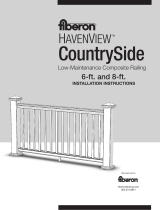
ENGLISH
5
6.
Install a #6 x ¾" set screw (F) on inside of rail,
ensuring set screws connect the beam with
the bracket, in the location shown in Figure
10. This should be as close as possible to the
inside face of the bracket so that the screw
still embeds.
Set the bottom beam in position between
the two posts, and ensure alignment (Fig 11).
Pre-drill the post for the center bracket screw
using a
1
/
8
" drill bit. Secure the brackets to
the post using 3 #10 x 2.5" mounting screws
(G) in each bracket, beginning with the center
screw hole (Fig. 12). If using with an RDI
structural post and screws come in contact
with steel, use #10 x 2" unpainted screws (I)
where necessary. This may occur in the screw
locations shown in Figure 10 depending on
the angle of the stair.
5.
Place the bottom rail (B) with routed slots
facing up, on the plank. Slide the bottom
rail on the plank between the posts until the
distance from the edge of the post to the
baluster rout is the same at both ends (Fig. 7).
Trace the angle of the post onto the bottom
rail at both ends (Fig. 8), and cut the rail at
these marks (Fig. 9).
Tip: Use a miter saw with a carbide tip blade
of at least 60 teeth.
(Fig. 8)
(Fig. 9)
(Fig. 12)
(Fig. 11)
4.
Wrap enough masking tape around the
bracket (Fig. 4) to make it slide snugly into
the end of the beam. Slide the bracket into
the end of the bottom beam. Align brackets
with angle marked on beam (Fig. 5) so that
when the cut is made, the entire face of the
bracket is cut but as little material is removed
as possible. With brackets secured into
bottom beam, cut through the beam and
bracket together on the marked line (Fig. 6)
to establish your installation angle.
(Fig. 5)
(Fig. 7)(Fig. 4)
(Fig. 6)
(Fig. 10)
Fasten set screw here
Top of stair
Bottom of stair













